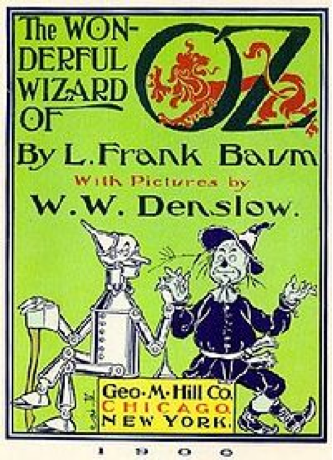
The Wizard of Oz
For over 100 years children around the world have been entertained with the adventures of Dorothy and her dog, Toto, as they traveled down the yellow brick road in search of the Wizard of Oz. It was L. Frank Baum who wrote the children’s novel The Wonderful Wizard of Oz in 1900, which has since been reprinted countless times under the name The Wizard of Oz. The 1939 film version starring Judy Garland as Dorothy was highly acclaimed and has been shown numerous times on television in the last 70 years. A lesser know fact is that it was due to the popularity of his first book that led to Baum's writing and having published thirteen more Oz books.
In 1900 Frank Baum was 44 and had been a chicken farmer, an actor, a seller of machinery lubricants, a purveyor of novelty goods and a newspaper publisher. All his life he'd written lively prose -- plays, ads, columns -- but most of it seemed to go nowhere. Then, suddenly, it did. The story of the wondrous Land of Oz burst from Baum's pencil, almost taking him by surprise. "The story really seemed to write itself," he told his publisher. "When I couldn't find any regular paper, I took anything at all, including a bunch of old envelopes." Baum recalled the experience of writing "Oz" as an epiphany: "It came to me right out of the blue. I think that sometimes the Great Author has a message to get across, and He has to use the instrument at hand. I happened to be the medium, and I believe the major key was given to me to open the doors to sympathy and understanding, joy, peace, and happiness."
Some scholars have theorized that the images and characters used by Baum closely resembled political images that were well known in the 1890s, specifically the debate of the day regarding monetary policy: the "Yellow Brick Road" represents the gold standard, it has also been suggested the cowardly Lion represented Wall Street investors, given the economic climate of the time. The Munchkins represented the common people (serfdom), while the emerald city represented Washington and its green-paper money delusion. The Wizard, a charlatan who tricks people into believing he wields immense power, would represent President William McKinley. It has been theorized that the name for the Land of Oz came from the abbreviation of ounces (oz.) used as the unit of measurement of gold. Historians, economists and literary scholars have examined and developed possible political interpretations of The Wonderful Wizard of Oz. However, the majority of the reading public simply takes the story at face value.
The MGM movie with actor Frank Morgan as the Wizard has been ranked among the top ten best movies of all-time in various critics' and popular polls, and it has provided many indelible quotes to the American cultural consciousness. Its signature song, "Over the Rainbow," sung by Judy Garland, has been voted the greatest movie song of all time by the American Film Institute ahead of Bing Crosby’s “White Christmas.”
Baum himself knew that something special had happened, that day in 1899 when he finally put down his favorite pencil and contemplated the handwritten "Oz" manuscript. He was so tickled with what he'd created that he picked up his pencil stub and framed it. Oh yes! The name "Oz" came from a file drawer labeled "O–Z" according to reports from Baum and his sons.
